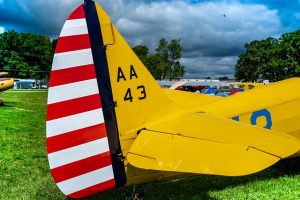
Airplanes feature a variety of flight control surfaces. In addition to ailerons and elevators, for instance, there are rudders. Many airplanes — particularly smaller airplanes — feature a single rudder. Like all other flight control surfaces, it allows pilots to control the airplane’s aerodynamic forces.
What Are Rudders?
Rudders are vertical flight control surfaces found on the tail. Pilots use it to change the airplane’s yaw. From the cockpit, pilots can swing the rudder to the left or right so that the airplane’s yaw changes.
Rudders aren’t exclusive to airplanes. They are used on boats as well. Rudders, in fact, were originally designed for boats. Over time, though, aerospace designers acknowledged the benefits of rudders in airplanes as well.
What Are Rudders Used For?
Some people assume that rudders are used to turn airplanes in a particular direction, but this isn’t necessarily true. On boats, rudders are, in fact, used for directional steering purposes. On airplanes, though, they are used to change the yaw. Yaw refers to an airplane’s vertical axis rotation. Pilots can adjust the law by engaging the rudder pedals.
Pilots don’t turn airplanes by engaging the rudder pedals. Instead, they rely on other flight control surfaces to turn, such as ailerons and spoilers. Pilots can engage these alternative flight control surfaces to turn the airplane to the left or right. Rudders simply control the nose of the airplane, which in turn affects the airplane’s yaw.
How Rudders Work
Different airplanes feature different rudder control systems. Nonetheless, most of them involve a pair of pedals. One of the pedals swings the rudder to the left, whereas the other pedal swings the rudder to the right. By pushing these pedals, pilots can change the orientation of the airplane’s rudder.
Rudder vs Vertical Stabilizer: What’s the Difference?
In addition to a rudder, many airplanes feature a vertical stabilizer. The vertical stabilizer is a long and vertical fin-like part of the tail empennage. Also known as the tail fin, it’s found on the far end of the airplane’s tail.
Rudders and vertical stabilizers aren’t the same. Rudders are classified as flight control surfaces because pilots can control them. Vertical stabilizers are not classified as flight control surfaces. A vertical stabilizer is a fixed, static part of an airplane’s empennage. There’s no way for pilots to control them, so they aren’t classified as flight control surfaces.



